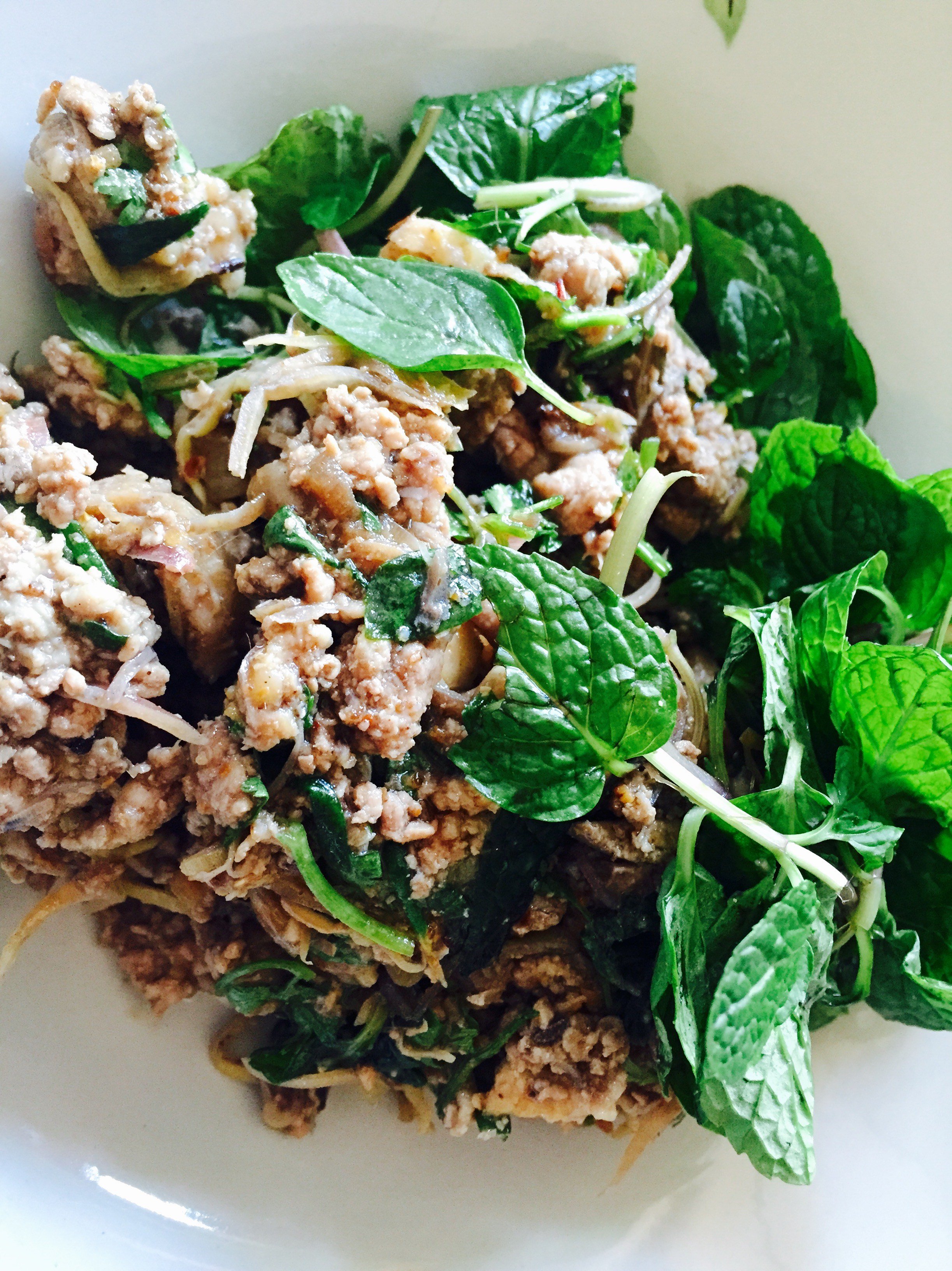Lucky Laab: A Brief History of Lao’s Beloved Dish
Written by: Khamphay Inthisorn
Edited by: Victoria Lasavath, Dorothy Culloty, Lasamee Kettavong
Photo: Channapha Khamvongsa, laab moo (pork laab)
A Brief History of Laab
Laab (Lao: ລາບ) is a type of meat salad from Laos and is one of the country's national dishes, along with green papaya salad and sticky rice. Considered Laos’ traditional party dish, a sort of “Lao tartar steak” (1), laab is also eaten in other Southeast Asian countries where the Lao people have migrated and extended their influence.
Early Europeans traveling through Laos in the 1800s described laab as Lao people’s favorite dish— a mixture of chopped shallots or scallions, lemongrass leaves, fermented fish and chili mixed with fresh and boiled fish. (2,3,4 )
Laab is fundamental to Lao cuisine and, depending on how the dish is prepared, it may be known by different names, including nam tok, goi/saa, or yum/sua. The main protein can be beef, buffalo, chicken, fish, game or even mushroom.
Traditionally, Lao people considered laab to be an auspicious and lucky dish because meat was not readily available. Most Lao people would normally eat laab at special occasions, such as a wedding, New Year celebrations and festivals (boun).
During the New Year, many Lao families believe that eating laab on day one of the three day celebration will bring good fortune for the rest of the year. Laab is so prominent in Lao culture that laab is mentioned in Lao blessing rituals. For example, a common blessing among Lao people is, “Kor Haii Sok Haii laab; Haii Lum Haii Louai der", meaning, "May you have opportunity, luck, and an abundance of wealth.” Similarly, when a Lao person invites guests over for dinner, they will often say, "Ma Ao Sok Ao laab”, or "Come get good luck and laab”.
Historically, one of the few widely published recipes for laab is found in a collection of handwritten recipes from Phia Sing (1898-1967), who served in Luang Prabang’s Royal Palace. Phia Sing's handwritten recipes were compiled and published for the first time in 1981. (5)
Making laab
In Laos, preparing laab and its variations is an art form. Laab is often made with chicken, beef, duck, fish, pork, mushrooms, shrimp or tao (algae), and flavored with fish sauce, padaek, toasted ground rice, lime and fresh herbs, including galanga, makrut leaves, scallions, cilantro, mint and either fresh chilies or chili flakes for spice. The beef, fish and shrimp laab can be served raw, which is known as aharn suer (tiger food), or cooked, but the chicken, pork and duck laab are always cooked.
For a dish to be considered laab, the meat is always minced, then cooked if desired/required and allowed to cool before mixing with toasted ground rice (khao khoua), fish sauce, padaek, lime juice, chili, mint, green onions or scallions. The dish is served at room temperature and eaten with sticky rice and raw or fresh vegetables, herbs and bitter tree leaves, if available.
Laab or its variations are always served with a soup made from broth developed from braising the bones and/or meat of the protein used for the laab. For example, meat soup with meat laab, fish soup with fish laab (laab pa). (6) Although more commonly, the main protein is served raw, dry-fried or only briefly braised in a little bit of water.
Traditionally, beef laab will contain offal, bile, and all of the other ingredients except lime juice. Fish and shrimp laab are also traditionally absent of lime juice, but incorporate minced galangal.
Fish and shrimp laab have an extra step. The deboned fish filet, or deveined, peeled shrimp is minced on a cutting board and pounded in a mortar and pestle until it turns to a gluey paste. While the paste is still in the mortar, padaek juice is slowly added to the mixture and stirred to a desired consistency. Finally, the finely chopped galangal and other aromatic herbs are mixed in. (7) With the exception of galangal, all other ingredients are the same.
As millions of people around the globe celebrate Lao New Year, there will be at least one type of laab dish on the pha khao (bamboo tray) or table to celebrate this most festive of occasions.
Kor Haii Sok Haii laab; Haii Lum Haii Louai der! "May you have opportunity, luck, and an abundance of wealth!”
1) Aymonier, Etienne (1895). Voyage dans le Laos, Volume 1 Annales du Musée Guimet: Bibliothèque d'études Voyage dans le Laos, Etienne Aymonier. E. Leroux. p. 166
2) Renaud, Georges (1895). "La France a L'Extérieur". Revue géographique internationale. 20–21: 237–240.
3) Estrade, doctor (1895). Manuel de conversation, franco-laotien: prononciation en français avec signes conventionnel, transcription de tous les termes en caractères laotien, Deuxième Edition (in French).
4) Berval, Rene de (1959). Kingdom of Laos: The Land of the Million White Elephants and of the White Parasol. p221-234.
5) Sing, Phia (1981). Traditional Recipes of Laos. London: Prospect Books.
6) Berval, Rene de (1959). Kingdom of Laos: The Land of the Million White Elephants and of the White Parasol. p221-234.
7) Sing, Phia (1981). Traditional Recipes of Laos. London: Prospect Books.
Written by Khamphay Inthisorn
Kemp was born in Laos, and currently lives in Ontario, Canada where he runs a Laotian Hot Sauce company and does private catering including Lao food classes. He is a researcher whose mission is to document authentic Lao food and to inspire beautiful new dishes that bring the spirit of Lao food to new audiences.


